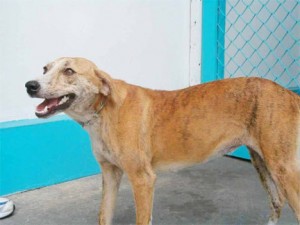Conclusion
The dog with impaired vision
I keep explaining to anyone who would listen that dogs have a pronounced sense of hearing and an acute sense of smell. Dogs are ‘ear and nose’ animals. They rely, least of all, on their sight to promote their well-being. Even the blind dog can survive quite well in his home environment. Please do not panic if the pet’s sight is impaired or if an eye/both eyes has/have to be removed. They will walk up and down the steps; they will manoeuvre their way around furniture and will circumvent most obstacles.
Over the last few weeks, we have been describing conditions of the eye and surrounding structures, all of which could lead to impaired vision and even blindness. Cataracts, glaucomas, retinal maladies, the keratitis-conjunctivitis complex, etc, if allowed to develop, will result in the prevention of light impacting on the optic nerve, thus impairing vision.
How will you notice when your pet is visually impaired?
(i) Uncertainty of gait: The companion animal (pet) will move around cautiously, placing the front feet (paws) very carefully on the ground. Sometimes, one notices that the animal is ‘high-stepping,’ ie raising one front foot high in the air before placing it on the ground, then repeating the same action with the next foot as the animal steps forward.
(ii) Walking on potentially dangerous articles that he would have hitherto not touched: Unfortunately, these articles could include broken glass or sharp objects which could cut the paws severely, thus causing great (even unstoppable) haemorrhage.
(iii) Bumping into fixtures: If the household furniture is rearranged, the animal might bump into a chair that is placed in a different position.
(iv) Actively sniffing the environment: On some occasions, one can notice that the dog is sniffing the ground as he walks forward. It is quite interesting to see these animals walking with their heads bent and their noses close to the ground.
(v) Usually, the pupils of a dog with impaired vision will be constantly (wide) open. This is an attempt to allow more light to reach the retina.

If you wish to confirm your suspicion that your dog is blind (or getting there), place him in an unaccustomed environment, especially during the dark. See if he bumps into objects. In fact, you may then turn on the lights and see if he makes the same mistakes.
Another more technical test would entail you shining a torchlight into the eye of the dog. The pupils should contract immediately. If they remain wide, that might be a signal that something is wrong with his vision.
Finally, owners must accept that even a blind dog can survive without experiencing great discomfort. Owners can be supportive by carrying the blind or vision-impaired dog out for walks on a leash. The dogs will accommodate themselves to the condition and we need not worry.
Importantly, the owner of a blind dog has to pay a lot more attention to his/her ward. For example the gate must remain closed at all times. Although the blind dog will accommodate itself to the immediate surroundings in his fenced yard, the dog is at a loss once it ventures out into the environment beyond the fence. He may be laughed at, teased, stoned and otherwise terrorized by some uncaring school children – or worse, the dog can be hit by a speeding mini-bus. A blind dog has no place on the open road, unprotected by an attendant.
This brings us to the end of our series on eye ailments. Next week, we’ll begin a new topic, probably ear maladies.
Please implement disease preventative measures (vaccinations, routine dewormings, monthly anti-heartworm medication, etc) and adopt-a-pet from the GSPCA’s Animal Clinic and Shelter at Robb Street and Orange Walk, if you have the wherewithal to care well for the animals. Do not stray your unwanted pets, take them to the GSPCA’s Clinic and Shelter instead. We still have the free spay and neutering programme. Exploit it. If you see anyone being cruel to an animal, or if you need any technical information, please get in touch with the Clinic and Shelter by calling 226-4237.








